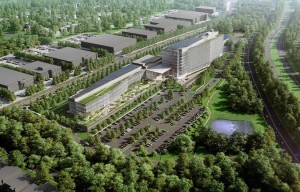
Reed Sparling is with Scenic Hudson, an environmental organization opposing plans by LG Electronics to construct a corporate headquarters atop the Hudson River Palisades. LG’s architect, HOK, proposes an 8-story slab that critics, such as Michael Kimmelman of the New York Times, maintains will despoil the scenic beauty of this National Natural Landmark. “LG is receiving the blame for constructing this building, and rightfully so,” writes Sparling in an email. “But does/should an architect have moral or civic responsibility to say no if a potential design threatens highly valued (and irreplaceable) natural resources?” It’s a good question. Architects are a service profession, and as such they tend to shed primary responsibility for the projects they design. “If we don’t do it someone else will,” is a common rationale. Or, as Philip Johnson famously put it, “Architects are pretty much high-class whores. We can turn down projects the way they can turn down some clients, but we’ve both got to say yes to someone if we want to stay in business.” Of course, architects say no regularly for a number of reasons: too small budget, too small project, too much other work. I remember as a student attending a lecture by Shadrach Woods. He made the claim that there were projects that architects should refuse to do on ethical grounds, and described an example of his firm (Candilis, Josic & Woods) turning down a commission for a parking garage. I think that Woods was right. Architects can’t have it both ways. They are quick enough to claim the moral high ground when they design affordable housing or green roofs, so they can hardly claim immunity when they carry out projects with harmful environmental or social side effects.

Phlip’s caustic remark is lamentably quite on-point, and not just this project but so many others provide evidence of our whorishness. The refain of ” if not me then someone else” is useful, but will you really be able to sleep at night? I say, look at the quality AND type of work a firm does to see into their soul.Sometimes it’s not a very pretty find…
I’ve just been reading Charles Moore’s evocative tribute to the Parthenon and all that went with it (Body, Memory and Architecture). Perhaps there were similar complaints at that time about despoiling a grand natural rise of land. History shows that architectural achievements can be rise and fall in favor over time. Let the building begin.
I’m suspicious that HOK’s role was not that passive, but actually rather proactive in promoting the height (and design) of the building. Wouldn’t it be naive to insist that a foreign consumer-electronics corporation, LG be sensitive enough to consider the site’s historical urban context? I’m almost sure that they do not have either the guts or capacity to confront the Palisades’ preservation legacy. The deal between LG and town of Englewood Cliffs, with the help of HOK as middleman, would have been impossible without the municipal planners’ and officials’ ambition to envision their town as a more high-density and bustling workplace, like their neighbor, Fort Lee. Englewood Cliffs has long been a home for large corporate headquarters: 3-4 story buildings with large footprints and even larger open parking lots. The town is almost full and no more land is available without chopping down the forest to continue the same type of development. The only way for the future is to shoot up. And LG’s site is actually close to the south border of town and not far from the high-rise buildings near the Bridge. While I understand the concerns of the environmentalists and the aesthetic connoisseurs about a potential chain reaction after LG, I’m dismayed that the current argument from the preservation groups and the Met is mainly about the VIEW. Saying No More Development in Englewood Cliffs is not realistic, or at least not morally justifiable. Do we support the current pattern of developement of Englewood Cliffs: low density, single-use, auto-centered, chronic traffic jams, vast area of asphalt? Should the planners of the town uphold the status-quo to protect the view from across the river? I think the core problem of the architect’s side is not that they didn’t say no, but they stuck to their design vocabulary of glass buildings. A lot of people were aghast at the image of the UFO-on-top-of-tree or the unsightly shiny mass, but no one seem bothered by the St. Peter’s College building facing the Cloisters.